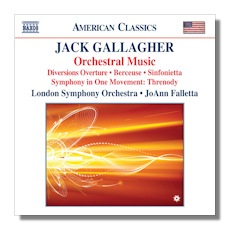
The Internet's Premier Classical Music Source
Related Links
- Gallagher Reviews
- Latest Reviews
- More Reviews
-
By Composer
-
Collections
DVD & Blu-ray
Books
Concert Reviews
Articles/Interviews
Software
Audio
Search Amazon
Recommended Links
Site News
 CD Review
CD Review
Jack Gallagher

Orchestral Music
- Diversions Overture (1986) 10:07
- Berceuse (1977) 5:19
- Sinfonietta for String Orchestra (1990/2007) 26:45
- Symphony in One Movement: Threnody (1991, rev. 2008) 21:36
London Symphony Orchestra/JoAnn Falletta
Naxos 8.559652 2009 63:47
This highly recommendable music by this very fine composer is certain to become better known, thanks to Naxos, Falletta and the LSO. Gallagher is the recipient of grants from the Ives Center for American Music, Yaddo, and Meet the Composer, among others, and the producer of a 2006 Grammy award-winning recording of a Messiaen work, but his previous dozen CDs have been on much well-known labels and, in common with works by other fine American composers, his compositions remain unperformed by major American orchestras.
Gallagher's "Threnody" symphony is a profoundly moving work. "Threnody" means lamentation, but much of this symphony is quiet and gentle. Dedicated to the memory of the composer's mother, its beginning is hushed and meditative. High divided strings play very softly a simple melody, and as they proceed are joined by lower strings, and briefly by piano, harp, muted trumpet, solo violin, percussion, horn, and woodwind, including bass clarinet. In his notes, Gallagher admits to an expression of longing. Halfway through, both tempo and dynamics increase markedly, to express a more vigorous lamentation, even the normal stage of grief that includes anger. Heavier orchestral forces including three trombones, tuba and more horns and trumpets and heavier percussion accentuate this. String lines become intense. Quietness returns with a harp cadenza, three quarters of the way through, with beautiful woodwind solos following, interrupted by some staccato and percussive playing and the work ends with some thumping whoops reminiscent of Sacre du printemps.
The Sinfonietta for String Ochestra, now in five movements, three fast and two slow, was originally in only two – hence the double date given. The opening is excitingly Bartókian, but much of the work seems in the English string orchestra tradition and is pleasingly melodic. The composer notes that the fast first movement – with some scurrying notes – is in modified sonata form and makes use of the octatonic scale with alternating whole and half tones. (Stravinsky sometimes used an octatonic scale and those interested can find a chapter on this scale in Arthur Berger's Reflections of an American Composer.) The second movement, "Intemezzo," is called by Gallagher a "plaintive arietta." High strings are featured and the melody is lovely. "Malamo," a scherzo in the form of a lively, syncopated Argentinian dance, forms the middle movement and is the longest. "Pavane," a very different kind of dance, is quiet, restrained, stately, flowing, and gentle. The final "Rondo concertante" features lively melody and rhythm. The whole work provides a very satisfying listening experience.
The gentle Berceuse grew out of a piano lullaby for friends, Gallagher tells us. The Orchestration is for pairs each of woodwinds, horns, trumpets, timpani and strings. A previous recording, on Vienna Modern Masters, has been widely broadcast, fifty times in Vienna alone.
Diversions Overture, which opens the disc, begins with lyrical music, sounding richly with fine woodwind writing. After about four minutes it becomes rousing and brash for a time but the ending is quiet, lyrical and flowing.
Gallagher, the Olive Williams Kettering Professor of music at the college of Wooster, Ohio, graduated cum laude and earned his doctorate at Cornell. His training shows diverse influences. Numbered among his distinguished teachers – not all as well known as they should be – are Elie Siegmeister, Robert Palmer, Burrill Phillips, Karel Husa, Thea Musgrave, and Ned Rorem, as well as Aaron Copland, George Crumb and William Bolcom, whose masterclasses he attended.
All of this music is highly listenable and attention-holding. (If the term were not so hackneyed I would call it "accessible.") The performances and recording quality on this disc are excellent and I have no hesitation in giving it a high recommendation.
Copyright © 2012, R. James Tobin





















